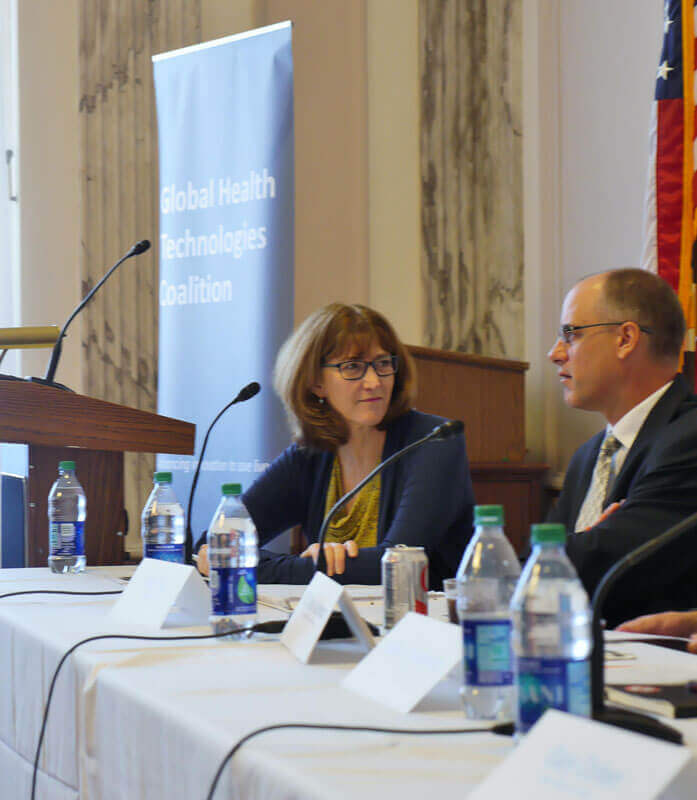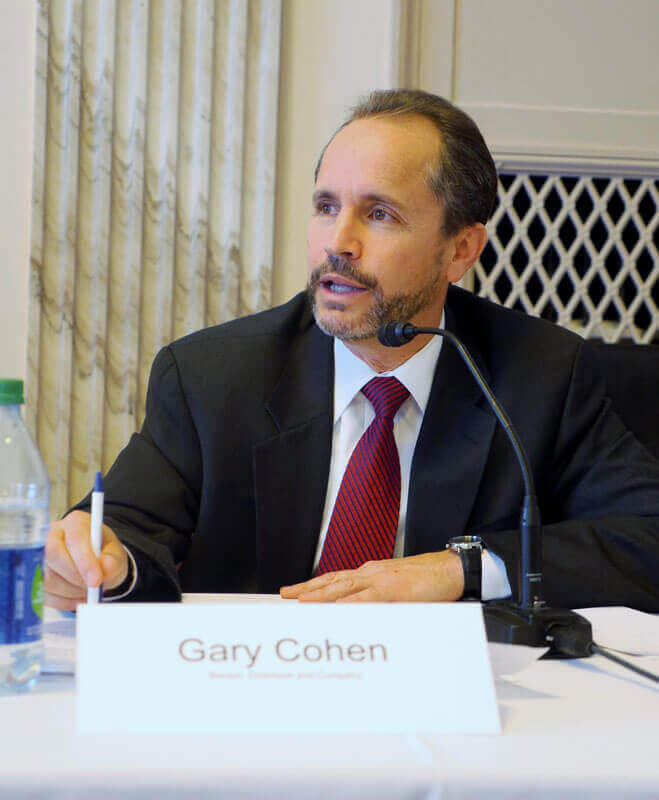
- Moderator Lisa Cohen and panelist Tony Pipa.
With the Sustainable Development Goals (SDGs) freshly adopted, the Global Health Technologies Coalition (GHTC) gathered representatives from the private,
public, and nonprofit sectors on Capitol Hill this past Wednesday to discuss what it will take to achieve the global goals. One message rang loud and
clear during the briefing: health innovation will be critical to achieving the SDGs, and it will take political commitment, funding, partnerships,
and accountability mechanisms to deliver the next generation of health innovations needed to get us there.
The panelists agreed that the SDGs—which set ambitious targets to end poverty, infectious disease epidemics, and preventable maternal and child deaths—are
an important device for catalyzing political commitment and driving collective action to improve global health. Anthony Pipa, the US special coordinator
for the Post-2015 Development Agenda, called the SDGs “a very optimistic global moment” and noted the power of the 193 United Nations member states
coming together to agree on a set of goals, a point reinforced by moderator Lisa Cohen, executive director of the Washington Global Health Alliance.
Pipa explained that the success of the Millennium Development Goals (MDGs) demonstrates the power of goal setting in advancing global health, and that
the SDGs must build on that success. But he also clarified that “the SDGs are not just the MDGs 2.0,” as the SDGs are broader and more ambitious than
the MDGs when it comes to health—they set goals to eliminate disease and preventable deaths, not just reduce them. He also described
the inclusivity of the development process and the universality of the agenda, which promoted a sense of ownership among member states that are now
starting to integrate the SDGs into their own national agendas. In the case of the US government, Pipa explained that the SDGs closely align with US
priorities in global health and reflect the government’s longstanding commitment to health research and development (R&D).

- Panelists Dr. Dean Jamison and Kaitlin Christenson
The need for strong and sustained investment in global health R&D to reach the SDGs was highlighted throughout the briefing. Dr. Dean Jamison, co-chair
of the Lancet Commission on Investing in Health, explained that “we benefit today from investments in R&D
of products made decades ago” and that health innovations have driven significant progress in global health over the past few decades. Jamison noted
the Lancet Commission report’s conclusion that it is possible to achieve the ambitious SDG vision, but not without greater investment in R&D for
new health technologies. He emphasized that, although health R&D can be a long and expensive process, it delivers huge returns on investment.
The panelists all underscored that, because the SDGs are so ambitious, no one sector alone can ensure their success. Instead, it will take partnerships
between the public, private, academic, philanthropic, and nonprofit spheres to reach the targets, particularly for health. Kaitlin Christenson, acting
director of Advocacy and Public Policy at PATH, discussed the importance of product development partnerships (PDPs)
in advancing the development of health technologies. Christenson remarked that PDPs leverage resources, expertise, and financing from across sectors
and help “multiply” the impact of public sector investment.

- Gary Cohen
Gary Cohen, senior vice president at BD, echoed this sentiment, noting that “so much of what we’ve achieved in health
is due to collaboration, we couldn’t see doing it any other way.” Moving a promising idea through product development, regulatory approval, scale up
of manufacturing, and market strengthening, in order to ultimately get the health innovation into the hands of patients who need it, is a daunting
process. It’s not possible to do this, Cohen explained, without the involvement of the private sector. Cohen noted that throughout the process of developing
the SDGs, it was widely acknowledged that the private sector would be critical to their successful implementation.
Christenson pointed out that, while it is clear new health tools are needed to reach the global goals, it is not just about designing any technology, but
the right technology. She explained that developers must stay focused on the needs of the end user and ensure that the product is affordable and contextually
appropriate in order to achieve the desired health impact. She also noted that the community must be diligent in identifying health technologies with
the greatest potential to drive dramatic improvements in health and rally the necessary investment and political support to bring them to scale. As
an example, she highlighted PATH’s Innovation Countdown 2030 initiative, which identifies 30 innovations with the
greatest promise to accelerate progress toward the SDGs.

- Attendees check out health technologies funded by US government investment.
Pipa also emphasized that reaching the SDGs will require “doing business differently” and pointed to innovation within the US government to promote new
thinking in global health, like USAID’s Saving Lives at Birth Grand Challenge. In the same vein, Christenson
pointed out that “innovation comes from everywhere, not just white-coated scientists” and called for systems and policies that support a broad view
of innovation. Cohen said that “innovation in business models will be just as important as innovation for technologies” and called for greater collaboration
among key players to ensure that R&D investments are translated from the development of new tools and technologies to the ultimate delivery and
use of lifesaving products.
An audience member from PATH pointed out that, despite the importance of new health technologies to achieving the SDGs, the agenda does not currently include
any indicator to measure progress in global health R&D, citing concern that “unless something is measured, it doesn’t necessarily happen.” Panelists
agreed that data and measurement is a critical part of ensuring we are on the right track to reach the health targets. Pipa highlighted the expanded
availability of data and the need to leverage data from different sectors, while Jamison cited the importance of data and monitoring in holding actors
accountable to their SDG commitments.
Though it will be a challenging road ahead to reach the SDG targets by 2030, the panelists were optimistic it could be done. Cohen emphasized that “these
seemingly intractable problems are solvable.” Pipa agreed, saying, “the political consensus around ending extreme poverty is really powerful, and we
shouldn’t underestimate that power.”




